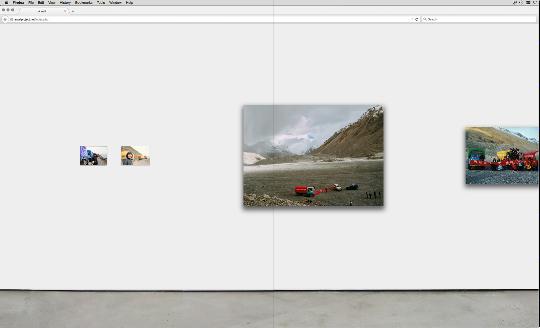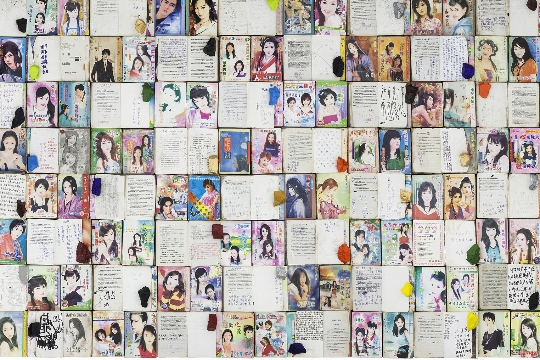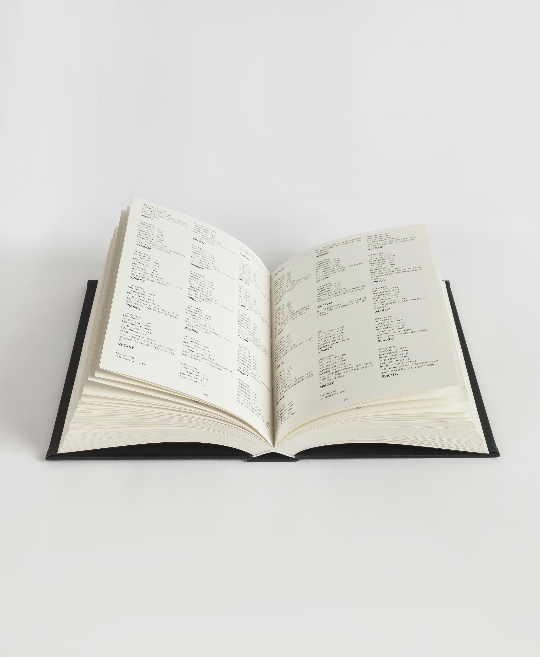ARTISTS’ ARCHIVES: THREE EXPERIMENTS
| December 24, 2015 | Post In LEAP 35

Zheng Bo: The Open Drawer
Artist Zheng Bo collects, organizes, and records information about public art projects through the website AWallProject.net. He has uploaded six projects to the site so far, from Mainland China, Hong Kong, and Taiwan. This online archive helps inspire Zheng’s own research and work, but also serves the very practical function of supporting offline teaching and discussions.
The website’s layout mimics a realistic display wall that may be dragged left or right to reveal more information. Zheng hopes to move away from the traditional webpage viewing experience and avoid the fragmented storage systems employed by traditional archives by employing an interface approximating a timeline in order to better showcase these projects. The things that are “hung” from this wall are not only works of art but also media reports, professional critiques, viewing notes, artist sketches, and other materials generated through the creative process. In a physical exhibit, these materials would be displayed in order of importance, but the online arrangement removes the hierarchy, returning the process of artistic creation to its original unaltered form, where the line between source material and final piece is blurred. More importantly, when all the material is shown openly on a single platform rather than hidden in some obscure drawer in the depths of an archival space, it is easier for viewers to systematically survey these art experiments from a bird’s-eye view.

Liu Chuang: Base Sentiment
Liu Chuang attempts to analyze the defining elements of pop culture using archaeological methods. The subjectively categorizes the available data for detailed review without following any particularly scientifically rigorous standard; instead he references the display methodologies used by museums. During his process, much time and energy is dedicated to the scanning and archival of collected materials. In Love Story (2014), Liu chose to study romantic novels from the 1990 to 2010s; most of the books in question were published in Taiwan and Hong Kong during the 1980s and 1990s. Book rental became a major business model during that time in Dongguan, Guangdong, a city known for its high concentration of migrant workers. Rental shops were a temporary low-cost network that started just as the Internet was taking off. The phenomenon began an accelerated decline in 2010, when the smartphone replaced traditional reading devices en masse.
In his description of the project, Liu analyzes the trajectory of romantic novels, as well as the shift in their reader base over time, in a systematic fashion. Anonymous statements—at once private and meaningless—exist in the public domain to serve only one special purpose: to leave a mark in book rental stores, public bathrooms, abandoned rooms. As a pulp and frivolous form of literature, the romantic novel claims massive numbers of readers. Liu converts the sentiments hidden in this cultural base into a visible and public form; he displays the books in the neat layouts typically seen on street stalls, but against the pure white background of the gallery they take on the aura of historical relics, their open pages betraying notes and comments written in the margins. Liu copies and enlarges some of the comments on the wall in assorted colors, installing a physical manifestation of an oft-ignored historical phenomenon.

Zhang Yue: Useless Time
In Zhang Yue’s Vavious Kinds of White, the artist lists 8136 shades of white using the Pantone color system. The samples of white used in his category descriptions come from subjective perceptual experiences and from images found in news broadcasts, while most of these samples are collected by the artist personally—some under rather unusual circumstances—this archive, created purely through one person’s brain power, presents a challenge to the standardized systems built on machine based data analysis augmented with cumulative experience. The identification, categorization, and management of archives tend to rely on scientific methodology. In Coho Salmon No. 00001 (2013), the Zhang bases his piece on an archived file, which he reproduces in order to create an existence for this imaginary salmon under the pretense of science, bestowing it with life in the ocean of future public knowledge. Through Zhang’s process, we see a targeted repetition of the same subject matter. This participation is based on the voluntary consumption and management of time. The creation, build-up, and management of an archive become a way to pass the time. (Translated by Frank Qian)

